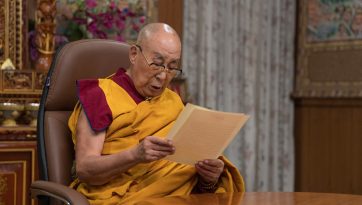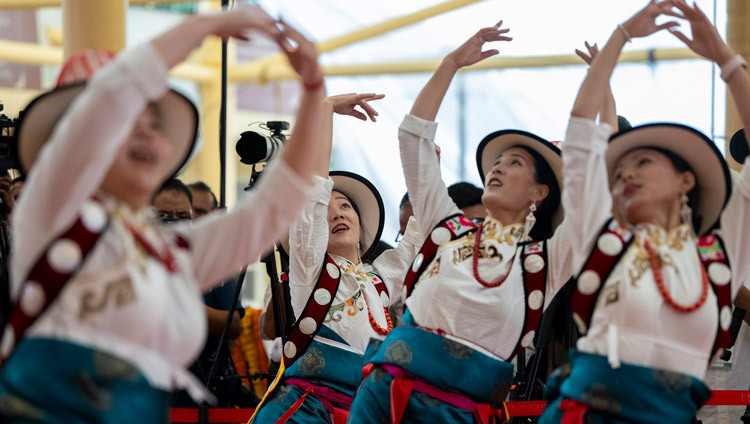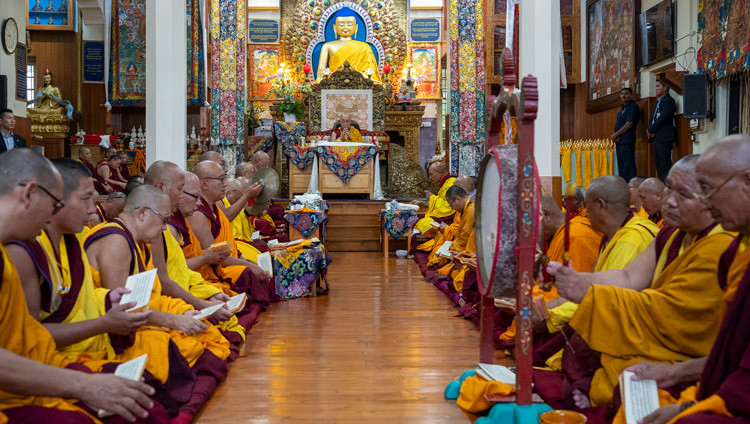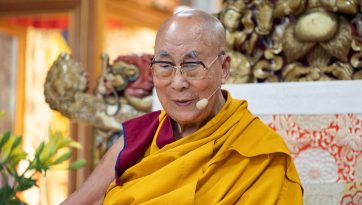Celebrating 25 Years of the Bharat Tibbat Sahyog Manch
Thekchen Chöling, Dharamsala, HP, India – This morning His Holiness the Dalai Lama attended a gathering in the Tsuglagkhang courtyard to celebrate the 25th anniversary of the founding of the Bharat Tibbat Sahyog Manch (BTSM), a pan-Indian Tibet support group. He was met at the gate to his residence by Dr Indresh Kumar, Chief Patron of the organization, and then stood for a moment while photographs were taken of members with him.

His Holiness the Dalai Lama arriving at the Main Tibetan Temple courtyard to attend Bharat Tibbat Sahyog Manch (BTSM) 25th Anniversary celebrations in Dharamsala, HP, India on May 5, 2023. Photo by Tenzin Choejor
As part of an Indian welcome His Holiness was presented with flowers and a lamp, and offered a tilak on his forehead. He was then given a traditional Tibetan welcome that included the ‘Chema Changpu’. As he walked up the central aisle, Tibetans in traditional dress held out katas, white silk scarves, to him. He stopped to watch Tashi Shölpa dancers from the Tibetan Institute of Performing Arts (TIPA). Before taking his seat, he participated in lighting a lamp before a portrait of Sarasvati to inaugurate the occasion.
The lady moderator told the audience how blessed they were to have His Holiness there with them. As part of a formal welcome of the Chief Guests they were each given a traditional Himachali hat. A colossal marigold garland was produced that encircled the entire group.
National General Secretary BTSM, Pankaj Goyal, spoke first opening his address with a rousing cheer of ‘Jai Bharat, Jai Tibbat’. He welcomed the chief guests and members of the audience. He mentioned that in the 25 years of its existence BTSM has established branches all over India. He described how proud members were to have His Holiness’s approval and how determined they were to maintain their support for Tibet.

National General Secretary BTSM, Pankaj Goyal, speaking at the Bharat Tibbat Sahyog Manch 25th Anniversary celebrations at the Main Tibetan Temple courtyard in Dharamsala, HP, India on May 5, 2023. Photo by Tenzin Choejor
Amongst its many activities BTSM takes people on pilgrimage to the Himalayas. Goal announced that Tibet will be free again one day and that Indians and Tibetans will celebrate together at Mt Kailash. In the meantime, one of the organization’s goals is to recruit more young people as members.
Chief Patron Indresh Kumar spoke next and referred to the historic connections between India and Tibet. He was full of praise for His Holiness. He noted how auspicious it was for the gathering to be taking place on Buddha Purnima and rejoiced that the Buddha’s teaching remains with us today.
Harking back to traditional tales of the struggle between good and evil, he observed that ultimately good triumphs through non-violence. He affirmed that BTSM takes a non-violent stance in its activities, adding that a resort to violence only brings harm to humanity.
He stated that it is important to take China to task for the way it has treated Tibet and Tibetans. He pledged that BTSM will to hold China to account while remembering all the Tibetans who have suffered under its occupation of Tibet. He recited the mantra ‘Om mani padme hung’.

Dr Indresh Kumar, Chief Patron of BTSM, speaking at the Bharat Tibbat Sahyog Manch 25th Anniversary celebrations at the Main Tibetan Temple courtyard in Dharamsala, HP, India on May 5, 2023. Photo by Tenzin Choejor
He alluded to BTSM plans to spread awareness of Tibet and promised to continue to work for the Tibetan cause. In conclusion he stated that Tibet was once a free country and has never been part of China. He ended with a cheer, “Jai Tibbat, Jai Bharat”.
His Holiness opened his remarks with the observation that after his coming into exile, Pandit Nehru arranged for him to live here in Dharamsala.
“India is a free country, a place where we found freedom of religion,” he declared. “All the world’s religions are represented here, but Buddhism originated in this country. This why all the books included in the Kangyur and Tengyur collections begin, ‘In the language of India the title of this work is …’ There have long been special connections between India and Tibet. This is where the profound traditions we maintain came from.
“In the 7th century the Tibetan King, Songtsen Gampo, married a Chinese princess which indicates the strong historic relations between Tibet and China. However, when it came to redesigning a Tibetan form of writing the King chose to base it on the Indian Devanagari alphabet with its vowels and consonants.
“From the time of Songtsen Gampo there were Chinese monks in Tibet. But a later King, Trisong Detsen, wished to evaluate the different Chinese and Indian approaches to Buddhist practice. He organized a debate between the Indian master Kamalashila and the Chinese monks. Kamalashila gave thorough explanations of the Three Higher Trainings and so forth, while the Chinese monks didn’t have a lot to say. The King decided that Kamalashila’s approach stressing the importance of study, reflection and meditation was more appropriate for Tibetans than the Chinese focus only on meditation. He asked the Chinese monks to leave Tibet.

His Holiness the Dalai Lama addressing the crowd at the Bharat Tibbat Sahyog Manch 25th Anniversary celebrations at the Main Tibetan Temple courtyard in Dharamsala, HP, India on May 5, 2023. Photo by Tenzin Choejor
“Shantarakshita, Kamalashila’s teacher and a great master at Nalanda University in India, had earlier been invited to Tibet. It was he who established the Nalanda tradition with its reliance on reason and logic in the Land of Snow. He further advised that since Tibetans had their own written language, instead of having to depend on Sanskrit or Chinese to read the scriptures, they should translate them into Tibetan. This is how the Kangyur—the translated words of the Buddha—and the Tengyur—the translated commentarial treatises of subsequent masters—came into being. Consequently, Tibetans today still explain the Buddha’s teachings according to the Nalanda Tradition.
“These days devotees and students from many Buddhist countries come to visit us here because we have upheld the complete teaching of the Buddha. What’s more, we practise as well as study. We cultivate resting as well as analytical meditation and read the scriptures and treatises in the light of logic and reason.
“When we engage in debate, particularly during examinations, if the challenger cites lines of scripture to justify his assertion the respondent takes off his hat as a mark of respect while he considers what has been said. However, if he concludes that the quotation doesn’t prove the point, he puts his hat back and says so.
“As for me, when I was a small boy, I began my studies with ‘Collected Topics. Then I moved on to the classic texts, several of which I memorized. I studied them with my tutors and debated what I’d understood with a team of debating assistants. Today, looking back, I feel fortunate to have encountered such learned scholars from our Buddhist centres of learning.
“Nowadays, because I’ve become so accustomed to taking an analytical point of view, whether I’m meeting with other religious scholars or even modern scientists, I feel I can confidently hold my own.
“Being able to conduct an investigative analysis is very precious. We don’t just accept blindly what we’re told, we examine the reason for things in a logical way.

Members of the crowd gathered at the Main Tibetan Temple courtyard listening to His Holiness the Dalai Lama during the Bharat Tibbat Sahyog Manch (BTSM) 25th Anniversary celebrations in Dharamsala, HP, India on May 5, 2023. Photo by Tenzin Choejor
“When I sat for my Geshé exams in Lhasa I had already been tested in debate in the three great monasteries of Ganden, Sera and Drepung. I was wearing my best clothes, but underneath their cover my heart was pounding nervously. After my exams I was able to engage in a combination of resting and analytical meditation. And this has helped me transform my mind.
“In Tibet the Dalai Lama sat on a high throne, but here in exile we have no such formality. I am motivated by the following verse from the end of Tsongkhapa’s ‘Great Treatise on the Stages to the Path to Enlightenment’:
Wherever the Buddha’s teaching has not spread
And wherever it has spread but has declined
May I, moved by great compassion, clearly elucidate
This treasury of excellent benefit and happiness for all.”
His Holiness explained how every day, as soon as he wakes, he meditates on the essence of the Buddha’s teaching—the awakening mind of bodhichitta and the view of emptiness. He declared that there are several thousand monks and nuns engaged in study, reflection and meditation in the monastic centres of learning re-established in India. He expressed his deep appreciation for what they are doing, because this is how the teaching is preserved. It requires a combination of study and practice. He urged them to continue.
He remarked that one innovation he can claim credit for is to have encouraged nuns to study and also become Geshémas. In Tibetan schools too he has advocated a shift of focus from religion to philosophy. Where there were once religious mentors there are now philosophy teachers.
“Here in exile, we have not been working only for our own benefit. By preserving the Kangyur and Tengyur and studying the books they contain we have upheld views of reality and a science of the mind that can be of widespread benefit to others in a purely secular context. And we have been able to do this thanks to the generous support and encouragement of the Government of India at both the central and local levels. In our schools children receive a modern education but they have also been able to keep our values and traditions alive.

Artists from the Tibetan Institute of Performing Arts (TIPA) performing at the Bharat Tibbat Sahyog Manch 25th Anniversary celebrations at the Main Tibetan Temple courtyard in Dharamsala, HP, India on May 5, 2023. Photo by Tenzin Choejor
“I would like to take this opportunity to thank the Government of India at the centre, as well as local authorities, for their great kindness to us.”
Applause swept through the audience.
“This Bharat Tibbat Sahyog Manch is celebrating its 25th anniversary. Under its auspices people from all over India have lent their support to Tibet. We have received backing from many quarters to preserve our culture and I’d like to thank everyone who has helped us.”
Before returning to his residence, His Holiness watched with pleasure as artistes from TIPA sang and performed a dance that originated in the Kongpo region of Tibet. The male dancers flourished bows, while the women carried quivers of arrows. His Holiness took one of these quivers and waved it in the air before him as mark of auspiciousness.




